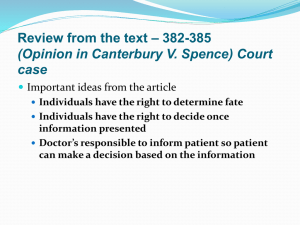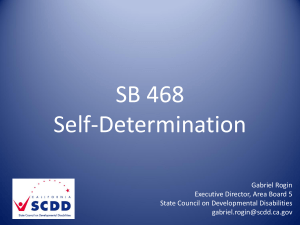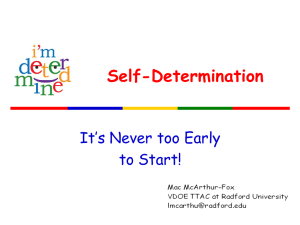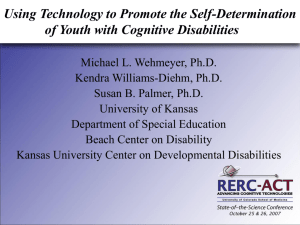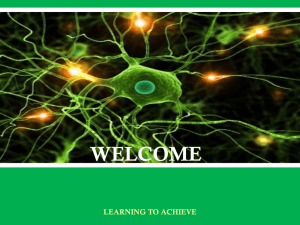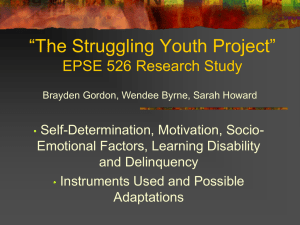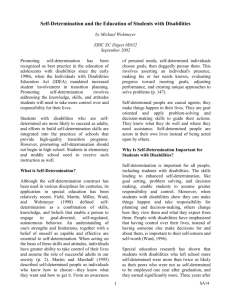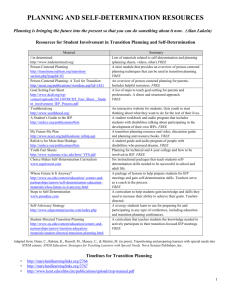TTC Project LEAD 2015
advertisement
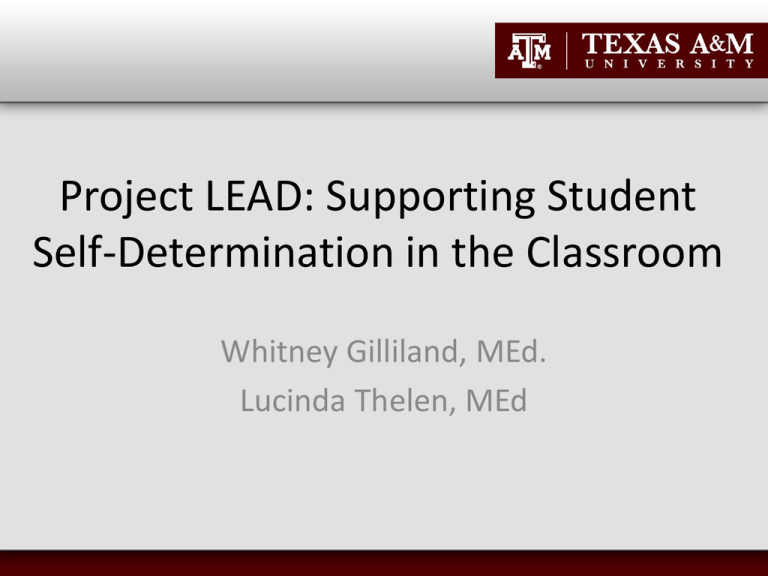
Project LEAD: Supporting Student Self-Determination in the Classroom Whitney Gilliland, MEd. Lucinda Thelen, MEd Introductions • Who are you? – – – – – – Parent? Educator? Student? Self-advocate? Disability professional? Other? • Who are we? – Leena • llandmark@cehd.tamu.edu – Eric • eric.roberts@tamu.edu – Lucinda Quiz • Self-determination is – An instructional program for students with disabilities – A set of skills used to take control of one’s life – An accommodation – Another word for perseverance Importance • Post-school – Students with disabilities who are self-determined • Are twice as likely to be employed one year after high school • Are more likely to have employment that includes benefits • More likely to be living away from the family home – Wehmeyer, 2002 Components of Self-Determination • • • • • • • Choice-making skills: indicating a preference from a group of two or more options Decision-making skills: generating potential solutions and selecting which potential solutions are best Problem-solving skills: identifying and defining a problem, generating potential solutions, and making judgments about the solutions Goal setting and attainment skills: identifying a goal and developing a series of tasks to achieve goal Self-regulation/self-management skills: setting goals, developing and implementing plans, evaluating outcomes of plans, changing actions if goals are not met Self-advocacy and leadership skills: having the knowledge and skills to speak on one’s own behalf and on the behalf of others Self-awareness and self-knowledge: knowing one’s strengths and limitations, understanding one’s own thinking and reasoning • Wehmeyer & Field, 2007 • • Jenny does well on tests, but her daily grades are low. Her teacher tells her she is failing language arts because she does not turn in her homework. To help Jenny, her teacher presents her with two solutions: (a) have her mother sign her homework every night so she will remember to do it or (b) stay for tutorials after school and complete her homework. Jessica wants a set of Beats, but they cost over $300. She thinks she can raise that amount of money by babysitting her cousins five nights ($12 hour, 5-6 hours a night). She calls her aunt to ask her if they will want to go on a date night soon so that she can babysit. YLF and Project LEAD • In a statewide effort to promote leadership and advocacy in Texans with disabilities, the Texas Council for Developmental Disabilities (TCDD) and TAMU have funded projects including – Texas Statewide Youth Leadership Forum (TXYLF) – Project LEAD (Leadership, Empowerment, Action, Determination) YLF • YLF is a 5 day advocacy training program provided free of charge to 30 to 35 youths with disabilities on a university campus in the state’s capital city • High school juniors and seniors with disabilities between the ages of 16 and 22 and located across the state apply to attend the training • Final participants are selected through a competitive review process TXYLF • TXYLF expanded the traditional model by including a 9 month support phase, follow-up training, and a mentorship opportunity • TXYLF included regional YLFs where participants attend multiple local forums during the year TXYLF • The goal of the TXYLF was – To develop young adults with disabilities who are capable of advocating for themselves and other individuals with disabilities – The youth who complete the TXYLF will become role models for other youth with disabilities in employment, independent living, and other adult living areas What we Learned from TXYLF • Intensive training with various activities improves youth knowledge base and experiences • Development and implementation of a leadership plan helped youth take actions • Extended support necessary for youth to carry out their plan and engage in leadership activities • Celebration of their success provides a rare opportunity for youth to show their accomplishments and develop motivation • Parent training was not provided but needed Project LEAD • Project LEAD was developed as an extension of the TXYLF – Involves collaboration between TAMU and local secondary schools to teach self-determination and leadership skills to students with disabilities and at-risk – Addresses the needs of students, parents, and educators • http://projectlead.tamu.edu Students Project LEAD Educators Parents Project LEAD for Educators • Self-determination pre-post assessment – ARC Self-Determination Scale • Research-based curriculum • Training/technical assistance to implement the curriculum Curriculum • 1, 2, 3, BREAK (Zhang & Woodruff, n.d.) – The 1, 2, 3, is how easy it is, and the BREAK means B – Be in control R – Realize your options E – Evaluate your options A – Act out the best choice K – Know you did your best! • 15 lessons – Strengths, weaknesses, and preferences – Wants and needs – Self-efficacy – Goal setting – Decision-making – Choice-making – Problem solving – IEP leadership and transition process – Self-evaluation The Educators • 14 teachers, 2 school districts – 5 middle school – 9 high school • Classes – – – – – – Resource LIFE skills VAC Social skills Adaptive behavior CASL (communication, academic, social learning) Project LEAD for Students • Increase self-determination and leadership skills by progressing through curriculum • Guest speakers • Leadership project • Celebration • Over 100 students participating this year! Guest Speaker • Rohan Murphy Worth a thousand words Community • Brazos Valley Center for Independent Living (BVCIL) • PATHS • Career Fair • Celebration Station Community Trips Leadership Projects • Students, individually or as a class, – Choose/identify a self-determination or leadership goal – List the steps needed to complete the goal (make a plan) – Identify people and resources who can help – Set a timeline – Follow the plan – Evaluate progress Project • Student lead IEPs – Different templates and picture supports depending on student need – Templates followed ARD/IEP procedures – Student would go over their slides either verbally, by pointing, or using switches Project LEAD for Parents • 6 parent seminars – College and the student with a disability – Self-determination and independent living skills – Transition services – TBD • Free childcare and dinner provided • Educators are encouraged to attend, also Tips for Teachers • For teachers – Integrate the self-determination components into lessons or use a selfdetermination curriculum (http://nsttac.org/content/student-focusedplanning-0) • • • • • – – – – – Encourage students to make choices about everyday activities Provide honest an specific feedback regarding choices and decisions made Help students identify strengths, interests, and preferences Teach the goal setting process Teach the problem solving process Model self-determination Include self-determination goals in the IEP/ARD Let students lead their IEP/ARD meetings (provide training and practice first) Have students write their own postsecondary goals, with assistance Have students identify accommodations • Morningstar, 2012; Virginia Department of Education, 2013; Wehmeyer & Field, 2007 Tips for Parents • For parents – Encourage your child to make choices about everyday activities – Provide honest and specific feedback regarding choices and decisions made – Help your child identify strengths, interests, and preferences – Talk to your child about the goal setting process including barriers they may encounter – Encourage disability awareness – Model self-determination – Help your child become involved in his or her IEP/ARD meeting – Help your child understand accommodations and how they help your child – Educate yourself and your child about rights • Indiana State University, 2013; Virginia Department of Education, 2013; Wehmeyer & Field, 2007 To Learn More… • Texas A&M University’s Center on Disability and Development
